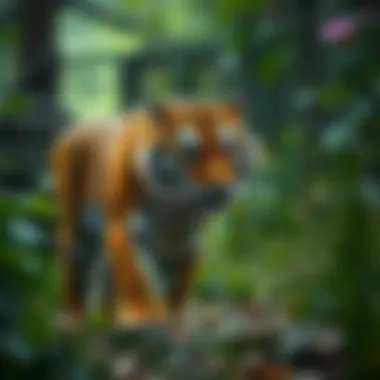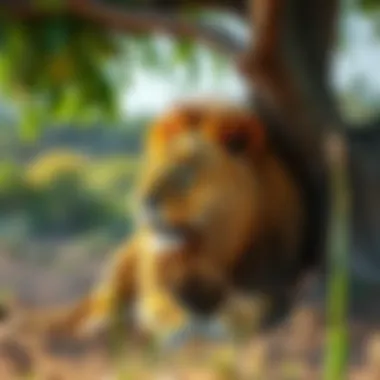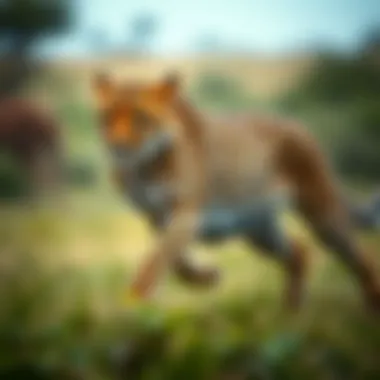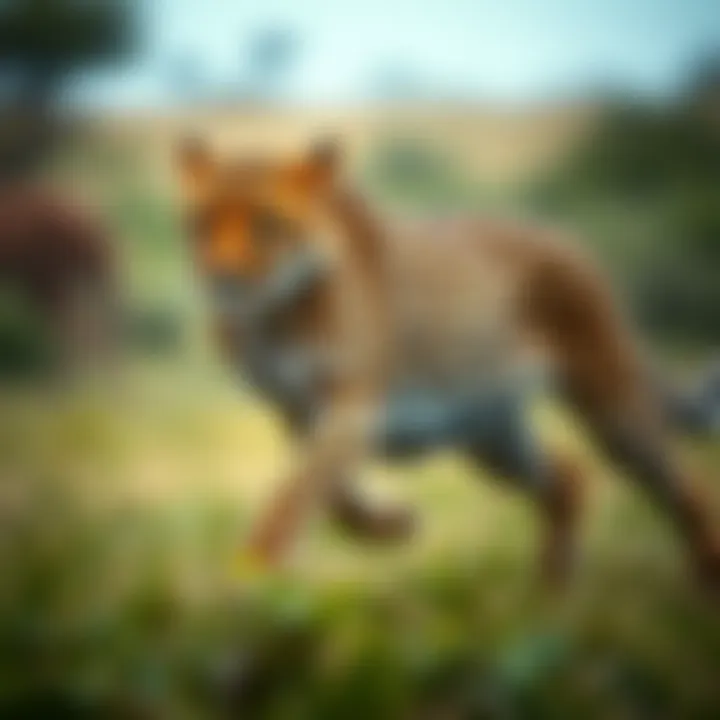Large Exotic Cats: Biology, Behavior, and Conservation


Intro
In a world where the roar of the wild still echoes through thick jungles and expansive savannas, large exotic cats reign supreme. These magnificent creatures, such as the tiger, lion, and leopard, fascinate many due to their sheer size, beauty, and hunting prowess. However, understanding these animals requires delving deeper than just their striking appearances.
The realm of large exotic cats extends beyond their physical traits; it includes their biological classifications, habitats, behavioral patterns, and the pressing challenges they face today. From conservation efforts to the moral complexities of ownership, every angle encapsulates a sophisticated narrative of survival and coexistence. With a keen eye for detail, this article takes a comprehensive look at the multifaceted world of large exotic cats. Through this exploration, readers will emerge with a richer understanding of their roles not only in nature but also in human culture.
Animal Species Profile
Preface to the animal species
Large exotic cats belong to the family Felidae, boasting several species that inhabit various regions around the globe. From the snowy landscapes of Siberian tigers to the sun-drenched plains where African lions roam, each species has adapted uniquely to its environment. These adaptations are as intriguing as they are necessary for survival, ensuring these creatures maintain their position as apex predators.
Physical characteristics and appearance
Each species of large exotic cats exhibits unique physical traits designed for survival. For instance, the Siberian tiger, with its thick, striped coat, is built to endure harsh winter climates, while the African lion possesses a tawny mane that serves as a lure for potential mates and a sign of dominance.
- Siberian Tiger: Largest subspecies, known for its thick fur and powerful build.
- African Lion: Social animals, recognized for their unique pride structure and majestic mane in males.
- Bengal Tiger: Noted for its striking orange coat with black stripes and robust physique.
- Leopard: Smaller in stature but is an exceptional climber, known for its adaptability in diverse environments.
Natural habitat and distribution
Large exotic cats are distributed across various continents, adapting well to their respective environments. They thrive in diverse ecosystems, including:
- Forests: Home to tigers, which prefer dense bush to stalk prey.
- Savannas: Lions dominate the grasslands where they work in prides to hunt.
- Mountains: Snow leopards inhabit rugged terrains, using their camouflage to blend into stony landscapes.
Behavior and social interactions
The behaviors exhibited by large exotic cats vary significantly, particularly between solitary species like the leopard and social ones like the lion. Many large cats are skilled hunters, relying on stealth and strength to catch their prey. Lions, in contrast, strategize as a group, showing strong social structures within prides. Understanding these social dynamics is essential to grasp how these magnificent animals thrive in their environments.
Conservation & Wildlife Efforts
Overview of conservation status
The conservation status of large exotic cats varies among species. While some, like the lion, are listed as vulnerable, others, such as the Amur leopard, are critically endangered. The ongoing loss of habitat, poaching, and human-wildlife conflict threaten their survival, making conservation efforts paramount.
Threats to the species
Several significant threats loom over these powerful felines:
- Habitat destruction: Urbanization and agriculture encroach on their natural territories.
- Poaching: Illegal hunting for skins and body parts persists despite legal protections.
- Climate change: Alterations in their habitats affect prey availability and breeding success.
Conservation initiatives and organizations
Various organizations are actively working to protect large exotic cats. Notable efforts include:
- World Wildlife Fund (WWF): Advocates for habitat protection and anti-poaching laws.
- Panthera: Focuses on preserving wild cats and their habitats worldwide.
- Wildlife Conservation Society (WCS): Implements programs to reduce human-wildlife conflict and protect ecosystems.
Success stories and impact
Successes have emerged from various conservation programs that have demonstrated tangible results:
- Increased tiger populations in India due to habitat protection efforts.
- Rewilding programs that have successfully reintroduced leopards in certain regions.
Animal Behavior & Psychology
Communication and language cues
Large exotic cats communicate through an array of vocalizations, body language, and scent marking. They convey messages of territory, mating readiness, and distress. For example, a tiger may use low growls or hisses to signal discomfort, while lions may communicate through roars to establish their territory over long distances.
Reproductive behavior and parenting
Reproduction plays a crucial role in ensuring the survival of these species. Cats like the snow leopard are so elusive that observing their breeding and parenting has proven to be a challenge, resulting in limited understanding of their behaviors.
Cognitive abilities and problem-solving skills
Many large cats exhibit advanced cognitive capabilities. Studies indicate that leopards can solve problems when hunting or dealing with challenges in their environment, showcasing a level of intelligence that is fascinating.
Emotional intelligence and social dynamics
The emotional dynamics of these large cats also highlight their social complexities. Lion prides showcase cooperation and familial bonds that help each member thrive, while solitary species like tigers rely on their instinctual and emotional cues for survival.
Unique Facts & Trivia
Little-known facts about the animal
Many captivating facts about large exotic cats often remain hidden, such as:
- A tiger's stripes are as unique as a human's fingerprint, making them identifiable.
- Lions sleep approximately 20 hours a day, conserving energy for their active hunting periods.
Surprising behaviors or adaptations
Surprising adaptations include the snow leopard's ability to leap over 30 feet and the cheetah’s incredible acceleration, allowing it to reach speeds of up to 70 mph in short bursts.
Fun trivia and quirky behaviors
Did you know that leopards are known to drag their kills up trees to avoid scavengers? This adaptability provides an essential survival strategy in the wild.


Record-breaking feats or abilities
Records of these cats often astound, like the Siberian tiger being able to take down prey nearly three times their body weight—a testament to their strength and hunting prowess.
Pet Care & Tips
Choosing the right pet for your lifestyle
Before contemplating pet ownership of exotic cats, one must weigh the complexities involved. While they may seem appealing, the realities can be daunting. It's crucial to research and understand the specific needs and requirements of any exotic pet.
Basic care requirements and habitat setup
Setting up a suitable habitat involves considerations like space, diet, and enrichment. Wild instincts require special attention, and providing an adequate environment is essential.
Health and wellness tips for pet longevity
Keeping exotic cats healthy means maintaining a balanced diet, regular veterinary care, and ample exercise to channel their natural behaviors.
Training techniques and behavioral enrichment ideas
Employing positive reinforcement techniques can foster a sense of trust and cooperation, resulting in a healthier environment for both the owner and the pet.
Preface to Large Exotic Cats
The majestic world of large exotic cats provides a glimpse into some of nature's most awe-inspiring creatures. These incredible animals, with their profound beauty and captivating behaviors, demand attention not just for their size but for their critical role in maintaining ecological balance. In discussing large exotic cats, we bring forth a variety of elements that highlight their importance, including their definitions, numerous species, the importance of their ecosystems, and the challenges they face.
Defining Large Exotic Cats
Large exotic cats are characterized primarily by their impressive size and distinct features that set them apart from the average domestic feline. These species range from the magnificent tiger to the regal lion, each carrying unique traits that are not only fascinating but also vital for biodiversity. Here’s a closer look at some defining characteristics:
- Size: These cats typically weigh anywhere from 100 pounds to over 600 pounds, with some, like the Siberian tiger, standing taller than most humans at the shoulder.
- Habitat: They inhabit diverse ecosystems, from the dense jungles of Southeast Asia to the open savannas of Africa.
- Social Structure: While some species, like lions, exhibit social behavior, others, like leopards, are predominantly solitary.
- Conservation Status: Many of these species are under threat, facing challenges that put their existence at risk.
Understanding large exotic cats involves acknowledging their place in the environment and distinguishing them from domesticated cats while appreciating their wild instincts and behaviors.
Importance in Biodiversity
The significance of large exotic cats in our ecosystems cannot be overstated. They are often considered apex predators, playing a focal role in regulating prey populations and maintaining the health of their habitats. Without these magnificent creatures, ecosystems can become unbalanced, leading to an overpopulation of certain species, which can further strain the environment. Some critical factors regarding their importance include:
- Ecosystem Balance: By controlling herbivore populations, large cats help maintain the vegetation and overall health of their habitats.
- Indicator Species: Their presence indicates the health of an ecosystem; when they thrive, it suggests a robust environment with diverse flora and fauna.
- Cultural Significance: These cats often hold symbolic importance in various cultures, representing strength, independence, and the wild spirit.
"Despite their might, large exotic cats are among the most endangered creatures, reminding us of the delicate balance of life on Earth."
Classification of Large Exotic Cats
Understanding the classification of large exotic cats is vital for several reasons. First, it provides a framework that helps in recognizing their biological relationships and evolutionary history. By classifying these majestic creatures, we can identify their unique traits and behaviors which further assist in their conservation efforts. The classification also plays a significant role when it comes to educating the public and understanding the ecological roles these species hold. Essentially, a deep dive into their classification allows enthusiasts and researchers alike to paint a clearer picture of these incredible animals and their place in our world.
Taxonomic Hierarchy
Taxonomic hierarchy of large exotic cats organizes these species into categories based on shared characteristics. The hierarchy generally starts with the family Felidae, which encompasses all cat species. Within this family, large exotic cats are often grouped under the subfamily Pantherinae, which include genera like Panthera (lions, tigers, leopards, and jaguars) and Neofelis (clouded leopards). Delving into this hierarchy offers insights into their genetic makeup and behavioral distinctions. For instance, the Panthera genus possesses the ability to roar, a unique trait that sets them apart from other cats.
Key Species Overview
Magnificent Tigers
Magnificent Tigers are a primary focus when studying large exotic cats. Their powerful physique and distinct orange coat marked with black stripes make them one of the most recognizable species in the world. This distinguishes them not just for beauty but shows how evolutionary adaptation aids in their hunting strategy. Tigers are solitary hunters, relying heavily on stealth and strength. This behavior contributes positively to their role in regulating prey populations, which in turn maintains ecological balance. Interestingly, their stripes offer excellent camouflage in the dense forests they inhabit, making them effective predators. However, the drawbacks include their solitary nature, which necessitates large territories that are becoming increasingly scarce due to habitat destruction.
Majestic Lions
When discussing Majestic Lions, one cannot overlook their unique social structures. Unlike most large cats, lions are known for their pride. A pride typically consists of several related females, their offspring, and a few males. This social system allows them to control a larger territory and enhances their survival rates, particularly during hunting. Lions primarily hunt in groups, showing that their collaborative nature is their key strength. However, the responsibility of pride dynamics can lead to conflicts and a higher mortality rate among males during power struggles for social dominance. These dynamics are vital for understanding conservation strategies in the wild and in captivity.
Powerful Leopards
Powerful Leopards stand out due to their adaptability. Known for their incredible climbing skills, leopards can haul prey up into trees to avoid scavengers. Their solitary nature allows them to thrive in various environments, from savannas to rainforests. Thus, they serve as indicators of ecosystem health due to their role as both predator and prey. Their spotted coats provide camouflage in various habitats. There lies a challenge, however; their habitat loss due to urban expansion and poaching presents significant risks to their population.
Graceful Cheetahs
Graceful Cheetahs are truly unique among large cats due to their unparalleled speed. They can reach speeds of up to 70 miles per hour, making them the fastest land animal. This speed is crucial for hunting, particularly when chasing down smaller ungulates in open savannahs. However, their slender build makes them less capable of taking on larger prey. Cheetahs also face challenges; unlike other big cats, they cannot roar, and their solitary or small social group dynamics mean they are susceptible to dangers from larger predators. Understanding these aspects can guide conservation efforts and also helps in cultivating a deeper appreciation for them in the wild.
Rare Snow Leopards
Rare Snow Leopards are often dubbed the "ghosts of the mountain" due to their elusive nature and stunning adaptations for cold habitats. With their thick fur and long tails, they navigate through rocky terrains with grace. Their primary advantage lies in their solitary hunting tactics, often tackling prey that are difficult for other predators. Snow leopards depend on specific mountainous regions, making them vulnerable to climate change and poaching. Preserving their habitats is critical not just for this species, but also for maintaining the biodiversity of mountainous ecosystems.
Geographical Distribution
Understanding the geographical distribution of large exotic cats is crucial for numerous reasons. These magnificent creatures inhabit various ecosystems across the globe, each with distinct characteristics that directly influence the species that can thrive there. This section delves into the habitats that support these apex predators and highlights why preserving these environments is essential for their survival.
Habitat Profiles
Large exotic cats are not a one-size-fits-all type of animal. Each species has adapted to specific environments, relying on the unique features of their habitats to meet their physical and behavioral needs. Here’s a closer look at some key habitats these cats call home:
- Tropical Rainforests: Dense forests provide ample cover and a rich hunting ground, making them ideal for the elusive jaguar and the charismatic clouded leopard. These cats are masters of stealth, relying on thick underbrush to ambush prey.
- Savannas and Grasslands: Iconic for their vast open spaces, these regions are the perfect domain for lions, which often hunt in packs to take down larger prey. The availability of low vegetation enables them to stalk their quarry effectively.
- Mountains: Species like the snow leopard find refuge in high altitudes, where cooler temperatures and rocky terrains provide safe havens from threats. Their unique adaptations allow them to traverse steep slopes and blend into the rugged landscapes.
- Wetlands: The serene, marshy landscapes are crucial for the elusive fishing cat, which specializes in hunting aquatic prey. Wagging tails and stealthy movements make them highly efficient hunters in these watery domains.
Each habitat not only supports the species that thrive within it but also mirrors the intricate web of life where every organism plays a role.
Conservation Areas
Conservation areas are crucial in protecting the delicate balance of ecosystems that large exotic cats inhabit. These areas, which can range from national parks to wildlife reserves, are established to provide safe spaces where wildlife can thrive without the incessant pressure of human encroachment. Some important aspects include:


- Protected Zones: Areas like the Serengeti National Park in Tanzania or the Ranthambore National Park in India offer sanctuary to large cats. These protected spaces not only preserve habitats but also create opportunities for species to interact and adapt.
- Biodiversity Hotspots: Large exotic cats are often indicators of a healthy ecosystem. Their presence signifies a rich biodiversity that includes various prey species. Conservation efforts often target these areas to maintain ecological integrity.
- Community Involvement: Engaging local communities is vital for conservation success. When communities see the value of preserving wildlife, they are more likely to participate in safeguarding these areas. Programs that involve education and sustainable practices help foster positive human-wildlife relationships.
"Healthy ecosystems are the backbone of habitats where large exotic cats thrive, and their conservation is intertwined with the well-being of our planet."
In summary, the geographical distribution of large exotic cats is not just a matter of knowing where they live; it’s a vital component of understanding their behavior, conservation needs, and the broader ecological frameworks in which they exist. Protecting their habitats ensures not only their survival but also the preservation of rich biodiversity that depends on them.
Behavioral Traits of Large Exotic Cats
Understanding the behavioral traits of large exotic cats is paramount to comprehending their complex lives. These behaviors not only influence their survival strategies but also provide insights into their social interactions and ecological roles. By studying their behavior, researchers and conservationists can develop more effective strategies to protect these majestic creatures and facilitate harmonious cohabitation with humans.
Social Structures
Social structures in large exotic cats can vary significantly, often influenced by their species, habitat, and environmental pressures. For instance, lions are notably sociable, living in prides that consist of related females and a few dominant males. This unique structure allows them to cooperate in hunting and protecting their territory. On the flip side, solitary hunters like leopards and tigers prefer to keep their distance, marking their territories through scent markings and vocalizations. This tendency toward solitary life can be a response to the availability of prey and the demand for personal space.
Key Insights:
- Lions: Cohesive family units enhance hunting success.
- Leopards & Tigers: Solitary behaviors reduce competition for resources.
"The social context of large exotic cats not only influences their behavior, but also shapes their survival strategies in the wild."
This diversity in social structures also impacts breeding behaviors. For example, female tigers tend to rear their young alone, while lionesses raise cubs together, sharing nursing duties. Such variations underscore the adaptability of these animals to their environments, balancing cooperation and individual survival effectively.
Communication Methods
Communication among large exotic cats encompasses a rich array of vocalizations, body language, and scent markings. Vocalizations can range from the deep roars of lions to the growls and chuffs of tigers. Each sound carries specific meanings, often linked to territory warning, mating calls, or distress signals.
Body language is equally important. A twitch of a tail or a change in posture can convey a wealth of information about their emotional state or intentions. For instance, a raised tail in a leopard might indicate confidence and preparedness, whereas a flattened ear position could signal fear or aggression. Scent marking plays a crucial role in communication as well, establishing territory boundaries and signaling reproductive status to potential mates.
In essence, communication among these felines is not one-dimensional; it's a complex tapestry of audible and physical signals that enhance their social interactions and survival.
Hunting and Feeding Patterns
The hunting and feeding patterns of large exotic cats are intricately linked to their survival and ecosystem roles. Each species exhibits unique strategies tailored to their environments. For instance, the cheetah, renowned for its remarkable speed, relies on short bursts of acceleration to catch prey in open savannas. Their social structure also influences hunting, often hunting with siblings or female groups, combining their strengths to capture larger game.
Conversely, tigers prefer to stalk and ambush, using their powerful bodies to take down prey with a stealthy approach. They often target large ungulates, leveraging their strength to bring down hefty animals like deer or wild boars.
Feeding patterns are equally fascinating; in the case of leopards, they often cache their kills in trees to protect them from scavengers. This behavior highlights their adaptability and problem-solving abilities in harsh environments.
Understanding these diverse hunting and feeding patterns can offer critical insights into the conservation of these species, identifying necessary habitat features and prey availability for their sustenance.
Challenges Faced by Large Exotic Cats
Large exotic cats, including lions, tigers, leopards, and others, may appear to reign as the undisputed titans of the wild, yet beneath their impressive exterior lies a web of challenges that threatens their existence. Understanding these challenges is vital not only for their preservation but also for maintaining balance in ecosystems where they play a critical role. Survival of these big cats hinges on confronting and mitigating various issues, from habitat loss to human-wildlife conflict. In this segment, we explore some key challenges, highlighting why tackling them is paramount for both wildlife resilience and human interests.
Habitat Loss
One of the gravest threats to large exotic cats is habitat loss. As urban areas expand, forests are cleared, and grasslands are converted for agriculture. This encroachment directly reduces the natural habitats where these magnificent felines roam, hunt, and breed. A decline in their territory leads to a cascading impact not just on their population, but also on the entire ecosystem.
"Every time we remove a piece of wild land, we cut a little deeper into the survival of these majestic creatures."
Lions, for instance, have lost around 90% of their historical range primarily due to human development. As their habitats shrink, they become more vulnerable to conflicts with humans, particularly as the search for food brings them into areas inhabited by livestock. Poaching of their prey further exacerbates the situation, leaving them with fewer resources to survive.
Poaching and Illegal Trade
Poaching remains a heart-wrenching reality for many species of large exotic cats. These majestic animals are hunted for various motives, including fur, bones, and other body parts, which are highly valued in black markets. Countries like China and Vietnam still see demand for items made from these endangered species, leading to relentless poaching.
The illegal wildlife trade creates a grueling cycle: the more cats are poached, the more extinction risk rises, further skewing the balance of species on which these predators depend. The consequences are dire; as their numbers dwindle, so too does the genetic diversity crucial for their long-term survival. Investing in anti-poaching initiatives and reinforcing the law is crucial to curb this dire trend.
Human-Wildlife Conflict
As human populations balloon and resources dwindle, interactions between large exotic cats and humans have become inevitable. Territories are shared, and conflicts erupt, particularly in areas where livestock farming is prevalent. When lions or leopards hunt livestock, farmers often retaliate, leading to further killings of the cats. This not only endangers individual animals but can also significantly impact local populations of these species.
Measures to reduce these conflicts include community awareness programs and implementing protective strategies for livestock, such as using guard dogs or fortified enclosures. Balancing human agricultural needs with the need to protect these big cats is essential. Education and pro-active collaboration can pave the way towards a symbiotic existence.
In summary, the challenges faced by large exotic cats call for urgent attention. Habitat destruction, poaching, and human-wildlife conflict are hallmarks of a deeply interconnected web of issues that require multi-faceted approaches for resolution. The survival of these majestic beings depends on all of us—educators, policymakers, and enthusiasts—to advocate for responsible conservation and harmonious coexistence.
Conservation Efforts
Conservation efforts are paramount in the pursuit of safeguarding large exotic cats. These creatures are not just magnificent in stature but play a vital role in their ecosystems, maintaining the balance of nature. Their protection touches upon ecological stability, biodiversity, and even cultural significance that intertwines with various societies. Initiatives to conserve these species address pressing issues such as habitat preservation, anti-poaching measures, and public education, making these efforts critical in ensuring the survival of both the species and their environments.
Global Initiatives
A multitude of global initiatives exists to confront the myriad of challenges faced by large exotic cats. Programs like the Global Tiger Initiative, for instance, aim to double the population of tigers worldwide by the year 2022. This ambitious goal sheds light on collaborative conservation efforts across countries with significant tiger habitats. Other example includes
- The Panthera Project, which focuses on the conservation of wild cats through research and awareness.
- The Wildlife Conservation Society actively promotes the conservation of wild populations and is engaged in various specific regional projects.
In addition to individualized animal conservation, more coalitional efforts amplify their reach. Conservation International pulls together partners, funding, and resources to tackle pressing threats to large exotic cats, aligning global conservation priorities.
Countries are also rolling up their sleeves to improve legislation and community engagement. Nations like India have implemented Project Tiger, a program aiming to secure larger habitats while also fostering human-wildlife compatibility through education. It's a win-win situation where both local communities and large exotic cats can prosper side by side.
Role of Organizations
Organizations play a critical role in conservation, acting as the backbone of efforts aimed at these majestic felines. They come in various forms, including international NGOs, local wildlife groups, and governmental organizations. Each entity contributes uniquely towards conservation efforts.
Key roles of these organizations include:


- Research: Conducting studies that examine population dynamics and habitat requirements.
- Advocacy: Promoting policy changes that strengthen wildlife protection laws at all levels of government.
- Education: Raising awareness among local communities about the importance of biodiversity and how individuals can help.
- Funding: Securing grants and donations to finance conservation projects that wouldn't be feasible otherwise.
A notable organization worth mentioning is WWF (World Wildlife Fund) which has launched various campaigns not only protecting the habitats of big cats but also improving the socio-economic situations of communities reliant on these ecosystems.
"Conservation isn’t merely about saving a species; it's about ensuring the entire ecological system thrives."
Through their multifaceted approach, organizations create a net of protection around large exotic cats, stressing the importance that these entities don’t exist in a vacuum but rather within a global network aimed at sustaining life on Earth.
Ethics of Ownership
The topic of ethics, particularly when it comes to owning large exotic cats, is a multifaceted discussion heavy with moral considerations and societal implications. As these magnificent creatures captivate the imagination of many, it becomes imperative to examine the motives behind ownership and the consequences that arise from it. A well-rounded exploration reveals that while having such regal beasts as pets may seem appealing on the surface, significant factors underscore why this practice is often fraught with more questions than answers.
Public Perception
Ownership of large exotic cats has become increasingly visible in popular culture, influencing how society views these animals. Many people romanticize the idea of having a lion or a tiger as a pet, often fueled by media portrayals. Films and television shows glamorizing the wildness of these animals create an allure that can overshadow the real-life challenges of raising them. However, this illusion can lead to misguided notions about their domestication.
In reality, large exotic cats are not pets like dogs or cats. They come with a myriad of behavioral and physical needs that cannot be met in a typical household environment. Many owners find themselves overwhelmed when confronted with the reality of caring for such powerful animals. Furthermore, incidents of unpredictability, dependency, and potential aggression often surface, leading to tragic outcomes for both the animal and the owner.
Moreover, public sentiment is swiftly shifting. Many individuals and advocacy groups are increasingly calling for stricter regulations on ownership, emphasizing that these creatures belong in their natural habitat or properly managed conservation settings. This shift signifies a growing awareness of animal rights and the necessity to prioritize the well-being of wildlife over personal desire.
Legal Implications
Legal aspects concerning ownership of large exotic cats vary widely across different regions, adding another layer of complexity. In some areas, owning such animals is entirely legal, with minimal oversight, leading to situations where unqualified individuals acquire them impulsively. Conversely, other regions have enacted stringent laws, requiring permits and licenses, often accompanied by extensive compliance measures aimed at protecting both the cats and the public.
These regulations aim to prevent potential hazards linked to irresponsible ownership. Individuals willing to invest in acquiring permits must generally demonstrate their ability to provide safe and appropriate conditions for these animals, which can include substantial financial commitments for housing, veterinary care, and daily maintenance. As such, it is evident that an ethical approach to ownership necessitates more than just the desire to own.
Nonetheless, enforcement can become a fuzzy area. There are numerous cases of large exotic cats being kept in poor conditions, either illegally or under the radar, illustrating a gap between legislation and practice. Furthermore, illicit trade and trafficking remain pressing issues, complicating the regulatory environment and often putting these magnificent creatures at greater risk.
"Understanding and respecting the complexities of animal ownership is vital in protecting both wildlife and human interests."
Ultimately, the ethical implications surrounding ownership of large exotic cats are not easily navigable. They involve a dance between human emotions, societal impressions, and legal considerations, requiring a sophisticated understanding for anyone even contemplating bringing one into their life.
The Role of Captive Breeding
Captive breeding plays a vital role in saving large exotic cats from the brink of extinction. As wild populations dwindle due to habitat loss, poaching, and human-wildlife conflict, breeding programs serve as a lifeline for these majestic creatures. The significance of captive breeding cannot be overstated; it not only supports genetic diversity but also provides crucial insights into the biology and behavior of these species. Wealthy zoos and dedicated conservation organizations engage in systematic breeding efforts, often backed by scientific research, to foster populations that may one day be reintroduced into their natural habitats.
Breeding Programs
Breeding programs vary widely in their methods and objectives. Some focus on breeding for conservation purposes, aiming to maintain genetic health and viability in endangered populations. Others aim for educational and research purposes, focusing on understanding the behaviors and needs of large exotic cats in controlled environments.
The importance of artificial insemination techniques has surged in recent years, allowing for a greater pool of genetic material to be used, which helps prevent inbreeding. Moreover, some programs offer educational outreach, where people can learn firsthand about the species' plight and gain appreciation for the conservation efforts underway.
- Key Elements of Successful Breeding Programs:These initiatives can encourage public interest in conservation, which is often essential for garnering financial support and participation in conservation efforts. Understanding these aspects helps underscore why captive breeding is not just a safety net but a strategic intervention in the conservation of large exotic cats.
- Genetic diversity management
- Educational outreach
- Collaboration with wildlife conservation organizations
Reintroduction Challenges
While captive breeding programs make significant strides, they face numerous hurdles when it comes to reintroducing these animals back into their natural environments. One primary challenge is the adaptation of animals raised in captivity to the wild. They might lack the necessary hunting skills or wariness needed to thrive outside their controlled environments. Additionally, reintroduced populations can also struggle with integrating into existing wild surroundings, where they face competition for resources from established residents.
- Challenges in Reintroduction:
- Lack of survival skills
- Habitat compatibility issues
- Potential conflicts with local human communities
Long-term monitoring of reintroduced populations is crucial, as it provides valuable insights into the effectiveness of breeding programs and highlights areas that need adjustment. By understanding these challenges, conservationists can tailor their approaches, thus maximizing the potential for success in bringing these majestic felines back into their rightful homes.
"Captive breeding serves not just as a safeguard for survival, but as a springboard for a hopeful future where humans and large cats can coexist."
In summary, the role of captive breeding is multifaceted, incorporating science, conservation, and public education. Each successful program paves the way for hope against extinction, emphasizing the nuanced relationship between humans and large exotic cats. Those engaged with animal conservation and wildlife education are vital in maintaining these efforts, as is the general public's support.
Cultural Significance
Understanding the cultural significance of large exotic cats offers profound insights into how humans relate to nature and the ecosystems surrounding them. From ancient times, these magnificent creatures have found their way into folklore, art, and even religious practices, symbolizing strength, power, and beauty. In various cultures, they are not merely animals but represent qualities and ideals that resonate deeply with human sentiments. Exploring this cultural tapestry not only enriches our appreciation of these big cats but also sheds light on conservation efforts and the role these species play in local communities.
Symbolism in Art and Literature
Large exotic cats have long been woven into the fabric of art and literature, where they serve as potent symbols. Historically, in ancient Egypt, the lion was revered as a guardian deity, embodying the protective qualities of the fierce and noble animal. In artworks, the image of a tiger often reflects ferocity and independence, while leopards are frequently used to convey elegance and stealth.
Modern literature continues this trend; think of the intimidating presence of a panther in a suspenseful narrative or the gentle, wise demeanor of a lion portraying leadership and courage. Characters like Aslan from C.S. Lewis's The Chronicles of Narnia evoke both strength and wisdom, linking back to a rich tradition in which large cats stand as metaphors for deeper, more complex themes.
Moreover, as colors, patterns, and physical forms of these cats permeate various artistic expressions, they stimulate reflection on broader themes of survival, resilience, and the consequences of humanity's actions on the natural world. This imagery resonates with audiences, fostering a cultural narrative that highlights the delicate relationships between humans and these majestic animals.
Conservation in Local Cultures
The role of large exotic cats in local cultures often intertwines with traditional beliefs and practices, which can drive conservation efforts or, at times, conflicts. For many indigenous tribes, these animals hold spiritual significance and are integral to their cultural identity. For example, the Maasai people of East Africa see lions as symbols of bravery and are historically known for their lion-hunting traditions. Such perspectives can either aid or hinder conservation efforts, depending on how communities view these cats and their roles in the ecosystem.
Engaging with local cultures provides a pathway to more effective conservation strategies. By respecting traditional beliefs, conservationists can develop programs that align with local values, promoting coexistence. Educational initiatives that illuminate the ecological roles these big cats play can foster a sense of stewardship within communities.
Finale
In this exploration of large exotic cats, we have dissected not only their magnificence but also the challenges that accompany their existence both in the wild and within human context. Understanding the vital roles these creatures play in their ecosystems, along with the barriers they encounter, highlights the delicate interplay between nature and human activity.
Recap of Importance
Large exotic cats, from tigers to leopards, are more than just symbols of strength and beauty; they are critical to maintaining ecological balance. Their predation keeps other populations in check, fosters biodiversity, and contributes to the adaptation of various species within their realms. Furthermore, these cats are keystones in their habitats, meaning that the health of their populations directly influences the health of the entire ecosystem. With poaching and habitat destruction looming over them, this balance is precariously threatened, underscoring the need for increased awareness and actionable conservation strategies.
"Protecting these magnificent creatures reflects our commitment to safeguarding life on Earth."
Call to Action for Conservation
Given the pressing plight facing large exotic cats, it is imperative that we all take a stand. Advocating for strong anti-poaching laws, supporting conservation organizations like the World Wildlife Fund, and pushing for ecological preservation initiatives are steps every individual can take. Engaging in community awareness programs can magnify our voices against illegal wildlife trade and habitat encroachment.
Each action, no matter how small, contributes to a larger movement towards the conservation of these majestic beings. Consider fostering natives species or volunteering for a local wildlife sanctuary that prioritizes the rehabilitation of exotic animals. Ultimately, our unified efforts play a pivotal role in ensuring that generations to come will not merely read about these extraordinary cats in books but will experience their awe-inspiring presence in the wild.







